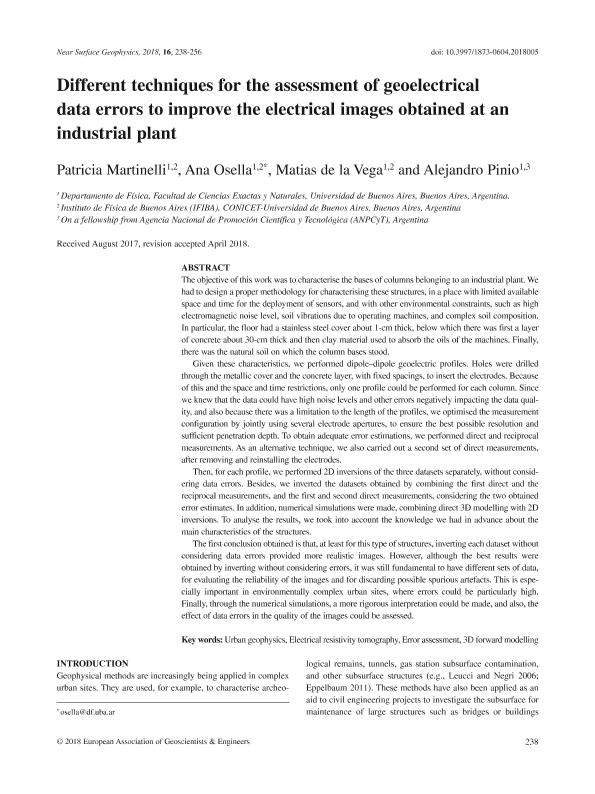Mostrar el registro sencillo del ítem
dc.contributor.author
Martinelli, Hilda Patricia

dc.contributor.author
Osella, Ana Maria

dc.contributor.author
de la Vega, Matias

dc.contributor.author
Pinio, Alejandro
dc.date.available
2023-08-14T15:14:04Z
dc.date.issued
2018-06
dc.identifier.citation
Martinelli, Hilda Patricia; Osella, Ana Maria; de la Vega, Matias; Pinio, Alejandro; Different techniques for the assessment of geoelectrical data errors to improve the electrical images obtained at an industrial plant; European Association of Geoscientists & Engineers; Near Surface Geophysics; 16; 3; 6-2018; 238-256
dc.identifier.issn
1569-4445
dc.identifier.uri
http://hdl.handle.net/11336/208160
dc.description.abstract
The objective of this work was to characterise the bases of columns belonging to an industrial plant. We had to design a proper methodology for characterising these structures, in a place with limited available space and time for the deployment of sensors, and with other environmental constraints, such as high electromagnetic noise level, soil vibrations due to operating machines, and complex soil composition. In particular, the floor had a stainless steel cover about 1-cm thick, below which there was first a layer of concrete about 30-cm thick and then clay material used to absorb the oils of the machines. Finally, there was the natural soil on which the column bases stood. Given these characteristics, we performed dipole–dipole geoelectric profiles. Holes were drilled through the metallic cover and the concrete layer, with fixed spacings, to insert the electrodes. Because of this and the space and time restrictions, only one profile could be performed for each column. Since we knew that the data could have high noise levels and other errors negatively impacting the data qual-ity, and also because there was a limitation to the length of the profiles, we optimised the measurement configuration by jointly using several electrode apertures, to ensure the best possible resolution and sufficient penetration depth. To obtain adequate error estimations, we performed direct and reciprocal measurements. As an alternative technique, we also carried out a second set of direct measurements, after removing and reinstalling the electrodes. Then, for each profile, we performed 2D inversions of the three datasets separately, without considering data errors. Besides, we inverted the datasets obtained by combining the first direct and the reciprocal measurements, and the first and second direct measurements, considering the two obtained error estimates. In addition, numerical simulations were made, combining direct 3D modelling with 2D inversions. To analyse the results, we took into account the knowledge we had in advance about the main characteristics of the structures. The first conclusion obtained is that, at least for this type of structures, inverting each dataset without considering data errors provided more realistic images. However, although the best results were obtained by inverting without considering errors, it was still fundamental to have different sets of data, for evaluating the reliability of the images and for discarding possible spurious artefacts. This is espe-cially important in environmentally complex urban sites, where errors could be particularly high. Finally, through the numerical simulations, a more rigorous interpretation could be made, and also, the effect of data errors in the quality of the images could be assessed.
dc.format
application/pdf
dc.language.iso
eng
dc.publisher
European Association of Geoscientists & Engineers

dc.rights
info:eu-repo/semantics/openAccess
dc.rights.uri
https://creativecommons.org/licenses/by-nc-sa/2.5/ar/
dc.subject
3D FORWARD MODELLING
dc.subject
ELECTRICAL RESISTIVITY TOMOGRAPHY
dc.subject
ERROR ASSESSMENT
dc.subject
URBAN GEOPHYSICS
dc.subject.classification
Ciencias Medioambientales

dc.subject.classification
Ciencias de la Tierra y relacionadas con el Medio Ambiente

dc.subject.classification
CIENCIAS NATURALES Y EXACTAS

dc.title
Different techniques for the assessment of geoelectrical data errors to improve the electrical images obtained at an industrial plant
dc.type
info:eu-repo/semantics/article
dc.type
info:ar-repo/semantics/artículo
dc.type
info:eu-repo/semantics/publishedVersion
dc.date.updated
2019-10-22T17:37:29Z
dc.journal.volume
16
dc.journal.number
3
dc.journal.pagination
238-256
dc.journal.pais
Países Bajos

dc.description.fil
Fil: Martinelli, Hilda Patricia. Consejo Nacional de Investigaciones Científicas y Técnicas. Oficina de Coordinación Administrativa Ciudad Universitaria. Instituto de Física de Buenos Aires. Universidad de Buenos Aires. Facultad de Ciencias Exactas y Naturales. Instituto de Física de Buenos Aires; Argentina
dc.description.fil
Fil: Osella, Ana Maria. Consejo Nacional de Investigaciones Científicas y Técnicas. Oficina de Coordinación Administrativa Ciudad Universitaria. Instituto de Física de Buenos Aires. Universidad de Buenos Aires. Facultad de Ciencias Exactas y Naturales. Instituto de Física de Buenos Aires; Argentina
dc.description.fil
Fil: de la Vega, Matias. Consejo Nacional de Investigaciones Científicas y Técnicas. Oficina de Coordinación Administrativa Ciudad Universitaria. Instituto de Física de Buenos Aires. Universidad de Buenos Aires. Facultad de Ciencias Exactas y Naturales. Instituto de Física de Buenos Aires; Argentina
dc.description.fil
Fil: Pinio, Alejandro. Universidad de Buenos Aires; Argentina
dc.journal.title
Near Surface Geophysics

dc.relation.alternativeid
info:eu-repo/semantics/altIdentifier/url/https://onlinelibrary.wiley.com/doi/full/10.1002/nsg.163001
dc.relation.alternativeid
info:eu-repo/semantics/altIdentifier/doi/http://dx.doi.org/10.1002/nsg.163001
Archivos asociados
